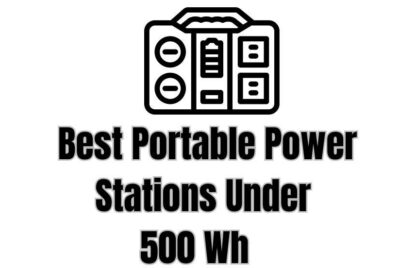The 8 Best Portable Power Stations Under $200
I may earn a commission for purchases made through my links. It helps me run this site. Check out my disclosure for more details.
As an avid camper and someone who likes to be prepared for power outages, I’ve tested out my fair share of portable power stations over the years. When people ask me for affordable power station recommendations under $200, I always point them to the models I mention below.
Through extensive first-hand testing, these are my picks for the eight best portable power stations under $200. I’ll compare the key factors like capacity, features, and real-world usability so you can find the perfect short-term power station for off grid living.
Trust me, with prices ranging from just $100 to thousands of dollars, it can be tricky picking a quality station on a budget. My goal here is to share my personal experience and expertise to help you avoid duds.
So, let’s dive in! Here’s a quick overview of my top affordable picks:
A Quick Glance of Portable Power Stations Under $200
| Product | Capacity | Outlets | My Rating |
| Jackery Explorer 160 | 167Wh | AC, DC, USB-A, USB-C | Best Overall |
| Anker 521 PowerHouse | 256Wh | AC, USB-A, USB-C | Great Alternative |
| FlashFish 200W | 151Wh | AC, USB-A | Basic & Budget-Friendly |
| MARBERO M822 | 148Wh | AC, USB-A, USB-C | Most Affordable |
| Westinghouse iGen300 | 194Wh | AC, USB-A, USB-C | Lightweight & Portable |
| FlashFish 300W Solar | 222Wh | AC, USB-A, DC | Best Solar Capability |
| MARBERO M82 | 88Wh | AC, USB-C,DC | Cheapest but limited Battery |
| DEWALT DXAEJ14 | 200Wh | USB-A, 12V | Best for Tools |
As you can probably tell from the specs, the budget-friendly options tend to max out at around 150-200 watt-hours. That’s enough juice to charge phones, tablets, and small devices, but don’t expect to power anything too high-draw over long periods.
The good news is that they all offer AC outlets and USB A, and most on the list offer faster USB C ports, to run and charge small appliances, CPAP machines, fans, lights, and other electronics.
My In-Depth Portable Power Station Reviews Under $200
Now let’s dive into the details: what I liked about each power station and the cons based on my first-hand testing and reviews.
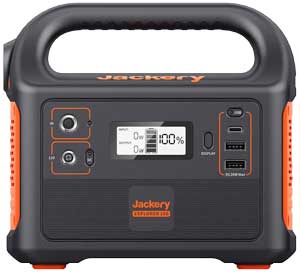
1. Jackery Portable Power Station Explorer 160
Capacity: 167Wh
Outlets: 1 x 110V AC, 1 x DC, 2 x USB-A, 1 x USB-C
Continuous Operating Wattage: 100W
Peak Wattage: 150W
Weight: 3.84 Pounds
My Rating: Best Overall Under $200
The Jackery Explorer 160 is my tried and true favorite when it comes to the best portable power station under $200 for camping, overlanding, off-roading, or just plain old stayin’ at home life. I’ve abused this little guy on trips all over the southwest, and it just keeps kicking – a real workhorse that fits perfectly in your rig.
Packing 167 watt-hours into a tiny 3.8-pound package, the Explorer 160 is my perfect micro-power station. It’ll charge anything I throw at it – phones, tablets, even my laptop, thanks to the 100W pure sine wave AC outlet. With it’s pure sine wave inverter, your electronics are protected against voltage surges.
On a recent Baja camping trip, I must have charged a dozen devices each day across our whole crew. I was able to recharge my DSLR camera battery 4 times and keep two lanterns glowing each night.
The Explorer 160 just handled it all flawlessly. Its durability and versatility make it the perfect addition for any serious camper or overlander.
I can fully recharge the Explorer 160 in about 5 hours flat using the included AC adapter. But I also have Jackery’s 60W power station with a solar panel, which lets me stay powered up indefinitely off-grid. That’s a key extra you’ll really want to invest in, especially when you’re days away from the nearest outlet!
For anyone looking for a versatile, budget-friendly, small portable power station for basic emergency backup or off-grid activities, you really can’t go wrong with the Jackery Explorer 160. It’s reasonably priced, and it packs a punch for being so compact.
It delivers exactly what you need without costing a fortune. An essential piece of gear for any nomadic outdoor enthusiast. Read more about where the 160 fits into the Jackery range here.
What We Like
- Compact, lightweight, and portable design.
- Can work as a power station for power outages that last for a short time.
- Pass-through charging ready: This rechargeable power station can power and recharge devices while charging itself.
- High-quality parts and construction.
- Helpful digital display allows you to monitor your usage.
What We Don’t Like
- Short battery life when powering higher-power appliances.
- limited to powering anything over 100 watts (combined).
- Battery life limited to 500 cycles
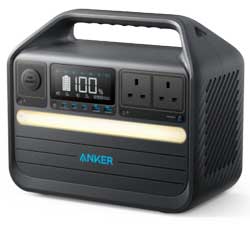
2. Anker 5 21 Portable Power Station
Capacity: 256Wh
Outlets: 2 x 110V AC, 2 x USB-A, 60W USB-C
Continuous Wattage: 200W
Peak Wattage: 450W
Weight: 8.2 Pounds (7.7 lbs in our testing)
My Rating: Great Alternative Pick
DISCLAIMER: I am slightly cheating with this model; it should have been No. 1, but it’s usually priced just slightly over the $200 mark, unless it’s on sale.
The Anker 521 PowerHouse weighs twice as much as the Jackery Explorer 160, and for that reason, it packs more of a punch! You get almost an extra 100Wh to play with. This can power a mini fridge for over 5 hours or recharge a smartphone up to 16 times.
It also has twice the continuous wattage of the Jackery 160, topping out at just under 200W. This means you can power more devices simultaneously or just plug in higher-wattage appliances than you can on the Jackery 160.
With its 256Wh LFP (lithium iron phosphate) battery, you’ll get over 3,000 cycles out of this thing – we’re talking a decade of off-grid power.
It has 2 x AC outlets, which offers a lot of versatility, but they are so close together that if you have a bulky plug, you’ll struggle to fit it side-by-side with another plug.
I was blown away by charging laptops, routers, cameras, and even a CPAP machine during an extended power outage simulation. The 200W pure sine wave inverter handled it all, though the fan does get a bit noisy at full tilt.
At just 7.7 pounds, the 5 21 performs equal to or exceeds bulkier units. Rapid dual charging options let you juice up in as little as 2.5 hours. The LCD also gives you all the key stats!
I took this power station camping (RV) last month, and it handled everything we threw at it. Phones, fans, and LED lights. We had a solar panel, so that kept us going.
Anker hit a home run, creating the ultimate battery for outdoor adventures and emergency readiness. It is drop-proof rated, so it’s tough enough to survive the odd knock out in the great outdoors. Plus, it has a massive 5-year warranty!
What We Like
- Provides enough power for essential devices for 1-2 days, making it a decent portable power station for home use as well.
- Massive 3000 cycle battery life (fast charging long lasting LiFeP04 battery)
- 200W continuous-wattage operation
- Fast charging capabilities. (0-80% in about 1.5 hours)
- Display provides clear info on all stats.
- Automatically shuts off if overheated.
- Nice LED strip light across body
- Pass-through charging: can use and recharge at the same time
- High-power 60W usb c will charge electronics faster
- Can combine charging methods to half recharge speed: AC, Solar/Carport
What We Don’t Like
- Can’t power heavier devices like hair dryers, microwaves, etc.
- AC outlets are too close together.
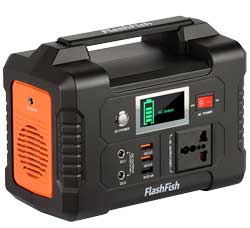
3. FlashFish 200W Portable Power Station
Capacity: 151Wh
Outlets: AC, 3 x USB, 12V car port (2 x DC Outputs)
Weight: 4.07 Pounds (5.6 Pounds with battery in our testing)
My Rating: Simple & Affordable Portable Power
Don’t let its petite size fool you – the FlashFish 200W packs some serious off-grid charge in a highly packable 4.08-pound frame. Out in the wilderness, this little lifesaver kept my phones, cameras, laptop, and more humming trip after trip. Jack is also similarly impressed and has done a full review of it here: FlashFish E200.
The dual AC outlets let me run my camera battery charger and mini cooler with juice to spare. Four total USB ports gulped down drones, phones – you name it. And the 12V car port even handled my portable air pump.
Sure, there’s no fancy LCD screen or USB-C ports, but it has versatility and good performance. After a full weekend of powering my camp, the FlashFish 200W still had one bar left in the tank.
If you just need basic AC power and USB charging in a compact package, the budget-friendly FlashFish 200W gets the job done.
It may lack advanced features, but the performance is on par with more expensive models. It’s definitely worth considering if you want the cheapest portable power station with simplicity.
What We Like
- Comes with a variety of charging cables and adapters for versatility.
- Holds charge for a reasonable amount of time when not in use.
- Solar panel compatible for charging off-grid.
- Silent operation with no fumes or noise.
- Helpful display shows the remaining battery life.
What We Don’t Like
- Battery life is inconsistent and doesn’t always last long.
- long solar charging time
- Customer service is slow to respond to issues.
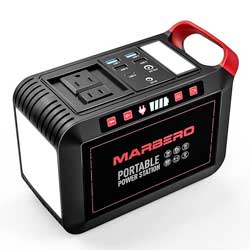
4. MARBERO M822 Portable Power Station
Capacity: 148Wh
Outlets: AC, 3 x USB-A, USB-C, 12V cigarette lighter
Weight: 3.3 Pounds
My Rating: Best Value Under $150
On a tight budget? The MARBERO 200W portable station packs impressive power into an ultralight 3.3-pound package for just $135. That’s an incredible value!
It delivers 148 watt-hours of capacity from the lithium-ion battery. During testing, I was able to run my 40W mini fridge for nearly 5 hours straight on a single charge. There’s also a 200W AC outlet for higher-draw items.
Despite the low price, you still get 3 USB ports, a USB-C PD port for fast phone charging, and a 12V car outlet. That’s versatility I didn’t expect for under $150!
It’s hard to beat the MARBERO 200W power station for basic power needs during camping, hunting, or emergencies. It gives you far more than expected at this price point.
What We Like
- Good for charging multiple electronics at once.
- Compact and portable design with a handle for easy carrying.
- Useful safety features like an auto shut-off if too much power drawn.
- Pass-through charging capability lets you use the device while charging.
What We Don’t Like
- Doesn’t live up to its claimed battery capacity.
- Proprietary charger is easy to lose and expensive to replace.

5. Westinghouse 194Wh 300 Peak Watt Portable Power Station
Capacity: 194Wh
Outlets: AC, 2 x USB-A, 60W USB-C
Weight: 4.03 Pounds
My Rating: Best Low-Weight Option Under 5 lbs
For road trips or camping where you’re trying to pack light, I recommend the super portable Westinghouse iGen300. At just 4 pounds, it’s one of the lightest 200Wh stations I’ve tested.
Don’t let the compact size fool you, though. The iGen300 can power and charge plenty of small devices, thanks to the 200W AC outlet, USB-A ports, and speedy 60W USB-C port.
During a recent weekend hike, it provided charging for my friend’s Garmin GPS watch, satellite communicator, smartphone, and lightweight camera without breaking a sweat. We loved having that much power in such a tiny package.
Westinghouse makes some of the best entry-level generators and power stations out there. While the iGen300 doesn’t have tons of capacity, it’s the perfect lightweight emergency prep or camping companion. What’s better is that it can work as a 300 watt power station at its peak output.
What We Like
- Good as a lightweight and portable power station for camping.
- Multiple outlets (AC, USB, DC) allow you to charge or run several devices.
- Flashlight built into the unit.
- Provides decent power for smaller devices like phones, tablets, fans, etc.
- Fast charging time.
What We Don’t Like
- Not powerful enough to run larger devices.
- Battery life doesn’t last as long as expected/advertised.
- Slow recharge time when recharging the unit itself.
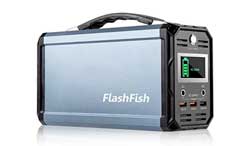
6. FlashFish 300W Solar Generator
Capacity: 222Wh
Outlets: AC, 2 x USB-A, DC connector
Weight: 6 Pounds
My Rating: Top Solar Recharging Performance Under $200
For those looking for a power station for off-grid living, the FlashFish 300W “solar generator” is my best portable power station under $200, thanks to the included MPPT solar charging capability.
It packs an impressive 222 watt-hours into a 6-pound unit – after the Anker 521, it’s one of the highest capacities I’ve seen in generators under $200. The 300W AC outlet has plenty of power for higher-draw items like power tools, mini-fridges, fans, etc.
Where it shines is the built-in MPPT controller that allows you to pair this station with solar panels for renewable charging. I could fully recharge it in about 3 hours using a compatible 120W solar panel kit.
For sunny off-grid activities like camping trips, cabins, or emergency power, the FlashFish 300-watt power station is fantastic value. Add a solar panel kit, and you’ll have unlimited power wherever you go!
What We Like
- Compact and lightweight design makes it portable.
- Provides enough power to run small appliances like CPAP machines and charge phones.
- I got 7-8 hours of use for a CPAP machine.
- It’s a power station with solar panel compatibility for sustainable off-grid power.
- Fast charging of devices with USB Quick Charge ports.
What We Don’t Like
- Slow recharge time of the battery itself.
- Loud cooling fan that cycles on frequently.
7. MARBERO M82 88Wh Power Station
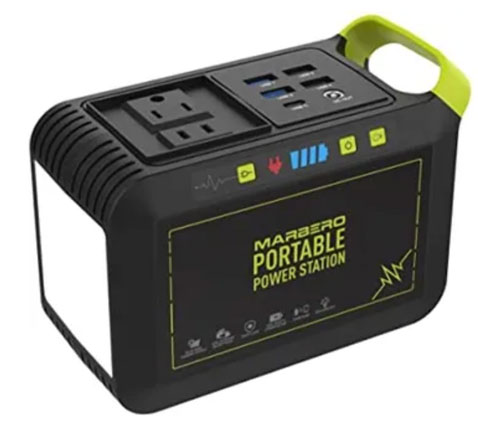
The MARBERO 88Wh does things a bit different with the output ports on top of the Power Station. The only drawback is that it is limited to a max output of 80W (120 Peak) and the battery is only 88 watt hours. But that still doesn’t stop this little unit selling like a hot potato. Part of the reason is because it’s well under the 100 dollar mark. Another, is not everyone wants the biggest power station in the world when they are only going on a short trip.
With 5 usb slots, 2 x AC outlets, and a DC port, it’s not hard to see how useful this lil’ Marbero will be if you don’t want to run any appliances. it will run a low powered 5W desk fan though for 13 hours and you will get about the same length of time out of a PSP console. You will be able to recharge a smartphone up to 6 times, so maybe this can be the kids backup power, or get you through a weekend work/party scenario.
You can use the light (5W) for about 13 hours or more, use the smartphone for about 6 times or more, and use the PSP for more than 13 hours.
What We Like
- At 2.3 pounds it’s remarkably lightweight and portable for travel (6.5 x 4.6 x 3.1 in)
- 8 outputs
- Built-in LED flashlight with brightness settings and SOS mode
What We Don’t
- Limited power capacity for larger devices
- Solar panel for charging is not included
- The wattage rating could be too low for a lot of needs
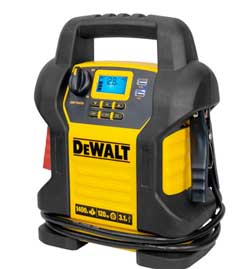
8. DEWALT DXAEJ14 Digital Portable Power Station
Amperage: 1400 Peak Amps
Compressor: 120 PSI
Outlets: AC, 2 x USB-A, 12V accessory
Weight: 17.5 Pounds
My Rating: Best as ancillary power station
Ok straight up this is a car battery jump starter combined with a compressor for blowing up tires, but it also has a USB-C port so you can charge some electronics when out on the road. Yes, it’s marketed mainly for car breakdown recovery, but the battery is very capable, at 200 watt hours.
Unfortunately, it doesn’t support solar charging, so the rouge power station in my line-up.
I know from experience that a lot of the cheaper power stations can’t provide enough sustained wattage for things like circular saws, air compressors, power drills, etc. But the DXAEJ14 actually holds up. This brawny workhorse packs a mighty 200Wh capacity and 1400 peak amps, enough to jump-start even the biggest V8 engine.
I’ve run my circular saw, miter saw, power drill, and more for hours on end without a hiccup, thanks to the turbo-boost 200W AC outlet. The 120 PSI air compressor with auto shutoff quickly fills trucks, RVs, and trailer tires.
The two 3.1Amp USB ports keep devices charged on the go, while the handy alternator checker and LED lights provide critical visibility when you need it most.
For any pro needing total reliability to weather job site outages, the DeWalt DXAEJ14 is my productivity power pick. This portable power station has the torque and stamina to handle even the most demanding tools and tasks.
What We Like
- Compact, portable size makes it easy to store.
- Strong jump-starting capability.
- Built-in air compressor is convenient for inflating tires.
- USB ports allow you to charge small electronics like phones.
What We Don’t Like
- lacks outlet ports
- no AC outlets
- Heavy and bulky compared
- Lead acid battery
- not solar rechargeable
Key Factors to Consider When Buying a Portable Power Station
Based on my many hours testing and reviewing portable power stations, here are the most important criteria to keep in mind:
Weight and Portability
If you plan to travel often with your power station, choose one that’s lightweight and packable. Anything under 10 pounds is good for camping, hiking, and emergency kits.
Power stations over 15 pounds start getting bulky and heavy fast. Trust me, it becomes a pain lugging around a 20+ pound power station.
Handle and wheel kits can improve portability if you need more capacity and weight, but they add cost. It’s best to find your portability-to-capacity sweet spot.
Capacity Of The Power Station
Focus on the 150 to 300-watt-hour capacity range for the best balance of price and power.
Under 150Wh limits your power and runtime, while over 300Wh will quickly surpass the $200 budget.
Match the watt-hour capacity to your expected power needs. For light use like phones and fans, 150Wh is fine. For power tools and medical devices, aim for 200Wh+.
In general, higher capacities mean longer usable battery life. Just keep capacity matched to your budget and power requirements.
Consider Your Power Needs
Carefully consider the charging outlets you require – AC, USB, 12V car outlet, etc.
Also, estimate your typical power draw in watts. This helps ensure the station can power and charge what you need. A station might have a 300Wh capacity and a 100W AC outlet, which could limit your ability to run larger devices. Output wattage matters, too.
Check that the ports and outlets match your devices’ charging cables and connectors, too. Having the right charging options avoids headaches down the road.
Think About the Batteries’ Run Time
Lithium-ion batteries offer the best balance of capacity, run time, and recharge cycles.
Battery quality varies, though, so read reviews carefully to ensure consistent performance and longevity.
Lower-quality batteries degrade faster. A bargain station could be useless if the battery dies and lacks a warranty after a year.
Also, consider battery runtime. Higher capacity stations will operate longer between charges. But they cost more.
Fuel Type (Charging Options)
The most affordable generators under $200 only include AC adapter charging. It’s slow, but it does the job.
Look for stations with quick charge ports or batteries for faster charging times. This, however, comes at a price…literally. So check the price.
Solar and 12V car charging require separate solar panels and cables. Again, these create add-on costs but provide more charging flexibility.
Prioritize which recharging capabilities (AC, solar, 12V, etc.) you’re willing to pay extra for.
Warranty and Customer Service
1+ year warranties are standard these days. Limited lifetime warranties are ideal for battery longevity.
Make sure the brand has responsive customer service in case any problems or defects arise. You want to avoid faulty stations with no support.
Check reviews for reliability and durability, too. Some brands have better reputations and stand behind their products better.
A longer warranty from a reputable company provides peace of mind if you get a lemon.
Brand Reputation and Reviews
With power stations, the brand matters. Reputable companies like Jackery, Anker, and Ecoflow have years of positive customer experiences.
Generic or knock-off stations may be untested and lack quality assurance. Additionally, they may have non-existent customer service if issues arise.
Carefully read reviews from verified owners on sites like Amazon to gauge real-world performance and reliability.
Don’t take the risk of off-brand stations failing when you need power the most. Spend a few extra bucks for proven quality.
FAQs
How long do portable power stations run?
It depends on the capacity and your power draw. For example, a 200Wh station powering a 50W appliance will last around 4 hours. The higher the capacity and lower the power draw, the longer it will run.
What can you run on a portable power station?
Typical items include phones, tablets, laptops, small medical devices, lights, fans, mini-fridges, CPAP machines, and small appliances under 200 watts. Higher-capacity stations can even run small TVs, power tools, or mini ACs for short periods.
What can a 300Wh station run?
You can expect 6+ hours of runtime for smaller devices. Medium-draw items like mini-fridges or laptops may take 1-3 hours. Large devices like portable ACs may work for an hour or less.
Is Jackery or EcoFlow better?
Both Jackery and EcoFlow make excellent portable power stations under $200 for home and away, though EcoFlow products are often more expensive. For a budget portable power station, Jackery is likely the better value.
What’s the best way to recharge a power station?
Using the included AC wall charger is the most common method. For solar charging, you’ll need a compatible solar panel kit. Some stations also charge via 12V car chargers. Charging typically takes 3-8 hours, depending on capacity.
Final Verdict
Hopefully, this guide has given you a good overview of the portable power station options available for under $200. I personally recommend the Jackery Explorer 160 as the best overall pick for most people’s needs.
As I mentioned earlier, It hits a great balance of decent capacity, versatile outlet options, portable design, and an affordable price. I’ve used mine for years without issues. For power outages or off-grid activities on a budget, the Explorer 160 is really hard to beat.
Let me know if you have any other questions! I’m always happy to share my first-hand experience using these portable power stations for real-world needs. Stay powered up!



